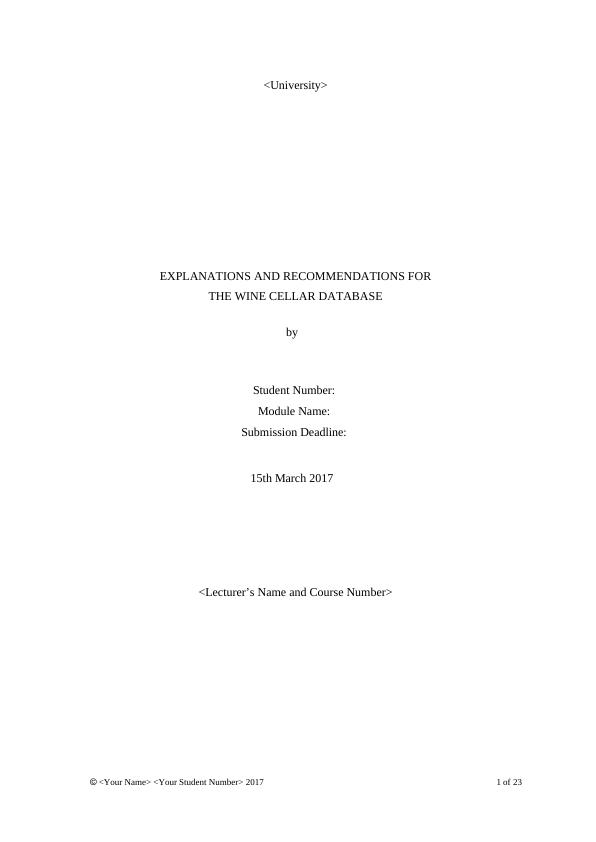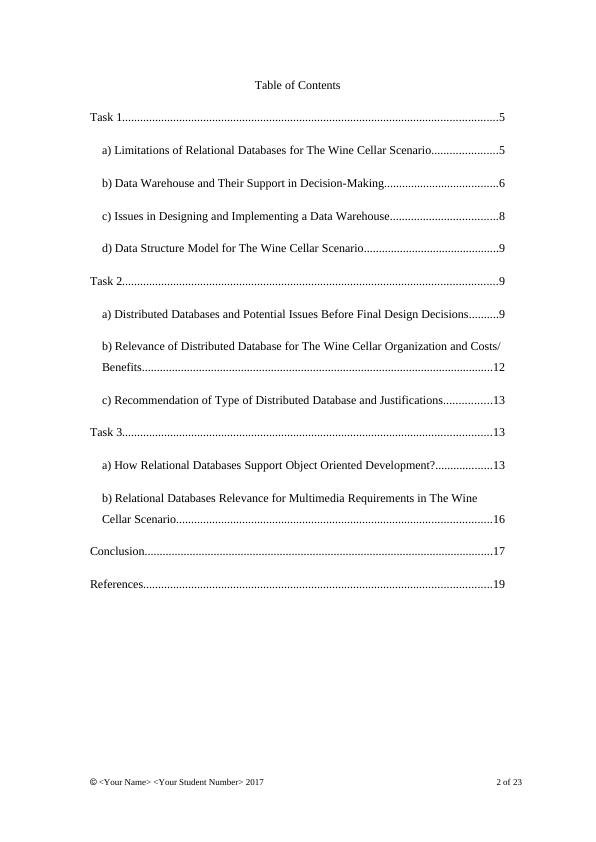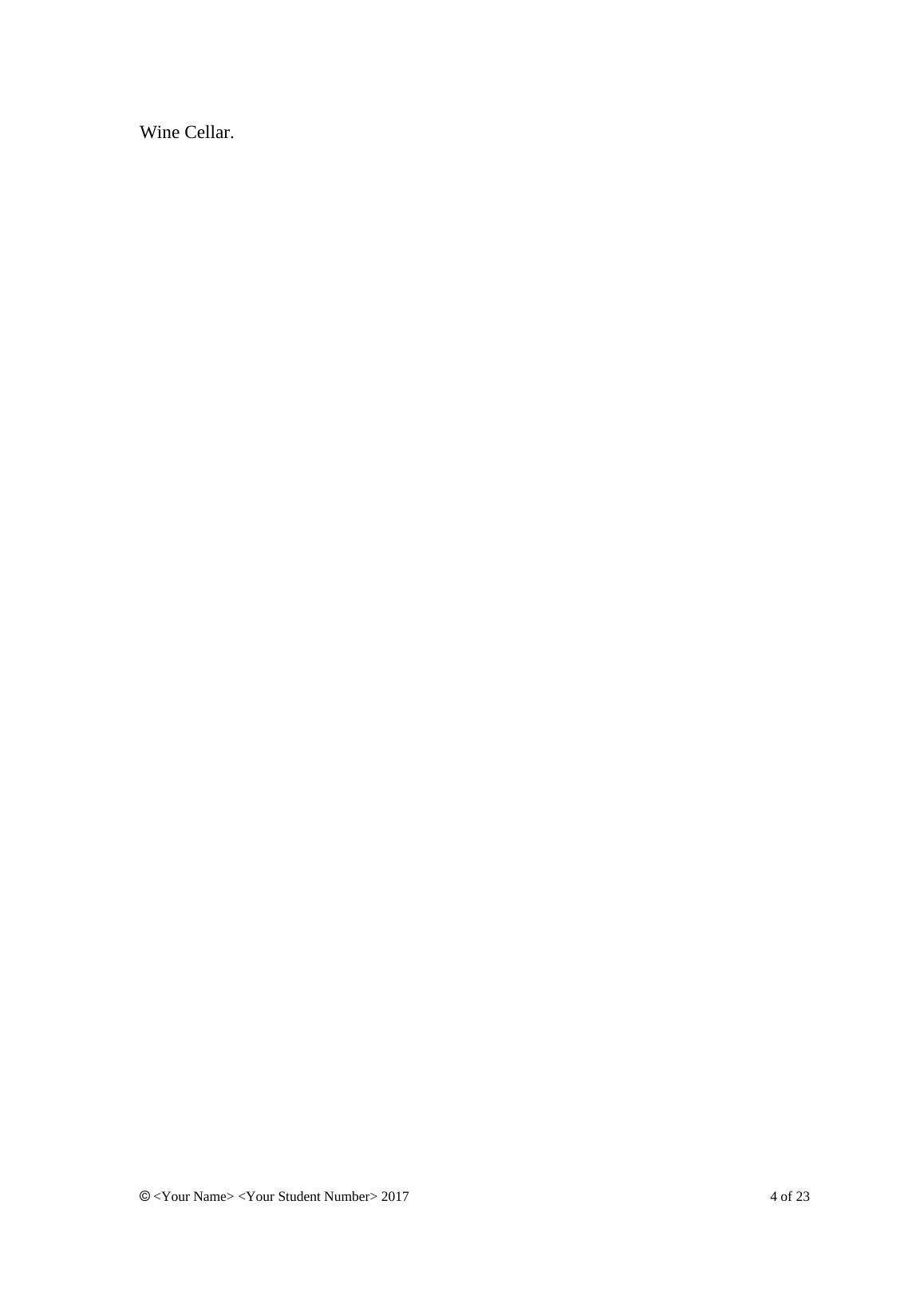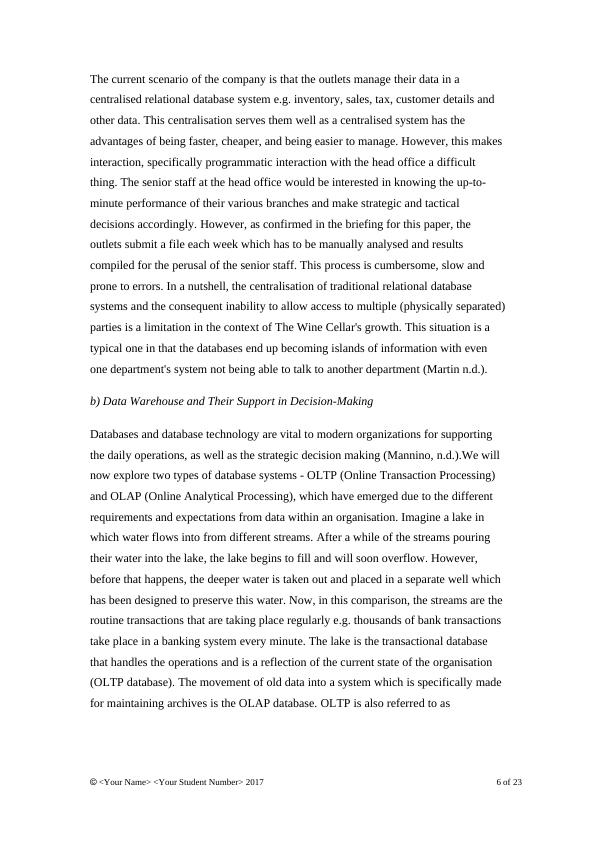Ask a question from expert
Explorations and Recommendations for the Wine Cellar Database
23 Pages7327 Words277 Views
Added on 2019-10-09
About This Document
This paper discusses the limitations of relational databases and the relevance of data warehouses for The Wine Cellar scenario. It explores the challenges in designing and implementing a data warehouse and provides a data structure model for the scenario. The paper also recommends a type of distributed database for the organization.
Explorations and Recommendations for the Wine Cellar Database
Added on 2019-10-09
BookmarkShareRelated Documents
<University>EXPLANATIONS AND RECOMMENDATIONS FORTHE WINE CELLAR DATABASEbyStudent Number: Module Name: Submission Deadline: 15th March 2017<Lecturer’s Name and Course Number> <Your Name> <Your Student Number> 20171 of 23

Table of ContentsTask 1.............................................................................................................................5a) Limitations of Relational Databases for The Wine Cellar Scenario......................5b) Data Warehouse and Their Support in Decision-Making......................................6c) Issues in Designing and Implementing a Data Warehouse....................................8d) Data Structure Model for The Wine Cellar Scenario.............................................9Task 2.............................................................................................................................9a) Distributed Databases and Potential Issues Before Final Design Decisions..........9b) Relevance of Distributed Database for The Wine Cellar Organization and Costs/Benefits.....................................................................................................................12c) Recommendation of Type of Distributed Database and Justifications................13Task 3...........................................................................................................................13a) How Relational Databases Support Object Oriented Development?...................13b) Relational Databases Relevance for Multimedia Requirements in The Wine Cellar Scenario.........................................................................................................16Conclusion....................................................................................................................17References....................................................................................................................19 <Your Name> <Your Student Number> 20172 of 23

Data is the oil that runs the machinery of the present-day society. Data is everywhere,and new is being generated every moment from many sources. In the present-daycompetitive world of advanced technologies, databases and database technology arevital to organizations for supporting the daily operations, as well as the strategicdecision making. Being able to store and retrieve data in an efficient way is anessential requirement for the success of any organisation. Also, different databases areoptimised for different roles. Some may be optimised for read-heavy operations, whileothers may be optimised for write-heavy operations. Optimising one parameter entailsa drawback in other parameters. Also, the underlying structure of a database systemhas a significant bearing on the applications. This paper deals with the newrequirements of a (fictitious) company in England, which is engaged in sourcing wineand accessories from all over the world and selling them. The company hasexperienced growth in the recent years and has opened branches throughout thecountry. However, the database handling is still keeping in mind a single location.The consequence has been the delay and manual effort required in compilingcompany-wide reports. In addition to the reporting requirement, the company alsowants to promote selected products via short videos on a website. This paper detailsthe various database technologies and provides recommendations for the newscenarios of reporting and multimedia promotions which have cropped up for The <Your Name> <Your Student Number> 20173 of 23

Wine Cellar. <Your Name> <Your Student Number> 20174 of 23

Task 1a) Limitations of Relational Databases for The Wine Cellar ScenarioIn the relational database paradigm, data is represented in the form of tables, and relations among the tables help enforce data consistency (Rouse 2006). In the process of developing relational database schema for a scenario, the entities to be represented in the database are identified first. Then, the parameters of these entities are recognised and finally the relations among them, so that there is no duplication of dataand any information about any entity is linked and can be traced. Such a paradigm allows for naturally enforcing constraints. This system was proposed in the 70s by E.F. Codd (Codd 1982, pp.109-117). Relational Database is implemented via tables, columns, rows, primary keys, and foreign keys. In other words, tables represent entities (e.g. products, customers), columns represent parameters about the entities (e.g. product name, manufacturing date, volume). The rows represent one particular instance of the entity (e.g. all the details of a single person), a primary key uniquely identifies each row in a table (e.g. social security number), and foreign keys map one row to another to implement relations.The key point to note from the preceding discussion is the foundation of the paradigm is relations, and indeed the relational database management system (RDBMS) are based on mathematical theories (Duffy 2011). Thus these systems are good at enforcing data consistency, both at the individual column level and in between tables. However, such systems are traditionally centralised, and this has both advantages and disadvantages. Till a few years, the centralised system was serving The Wine Cellar well, but the geographical distribution of the sources of data to different outlets call for another solution. By centralisation, we mean that the entire database system - the software to manage the data, the computer hardware, and the data are located on a single machine in a single location. This type of a concentrated architecture has some advantages and disadvantages. As we will see in a moment, the centralised systems serve the outlets of The Wine Cellar well but fail when it comes to company-wide manoeuvring. <Your Name> <Your Student Number> 20175 of 23

The current scenario of the company is that the outlets manage their data in a centralised relational database system e.g. inventory, sales, tax, customer details and other data. This centralisation serves them well as a centralised system has the advantages of being faster, cheaper, and being easier to manage. However, this makes interaction, specifically programmatic interaction with the head office a difficult thing. The senior staff at the head office would be interested in knowing the up-to-minute performance of their various branches and make strategic and tactical decisions accordingly. However, as confirmed in the briefing for this paper, the outlets submit a file each week which has to be manually analysed and results compiled for the perusal of the senior staff. This process is cumbersome, slow and prone to errors. In a nutshell, the centralisation of traditional relational database systems and the consequent inability to allow access to multiple (physically separated)parties is a limitation in the context of The Wine Cellar's growth. This situation is a typical one in that the databases end up becoming islands of information with even one department's system not being able to talk to another department (Martin n.d.).b) Data Warehouse and Their Support in Decision-MakingDatabases and database technology are vital to modern organizations for supporting the daily operations, as well as the strategic decision making (Mannino, n.d.).We will now explore two types of database systems - OLTP (Online Transaction Processing) and OLAP (Online Analytical Processing), which have emerged due to the different requirements and expectations from data within an organisation. Imagine a lake in which water flows into from different streams. After a while of the streams pouring their water into the lake, the lake begins to fill and will soon overflow. However, before that happens, the deeper water is taken out and placed in a separate well which has been designed to preserve this water. Now, in this comparison, the streams are theroutine transactions that are taking place regularly e.g. thousands of bank transactions take place in a banking system every minute. The lake is the transactional database that handles the operations and is a reflection of the current state of the organisation (OLTP database). The movement of old data into a system which is specifically madefor maintaining archives is the OLAP database. OLTP is also referred to as <Your Name> <Your Student Number> 20176 of 23

End of preview
Want to access all the pages? Upload your documents or become a member.
Related Documents
The Wine Cellar Database 5 Data Warehouse Task 15 Limitations of Relational Databases for The Wine Cellar Scenario 5 Data Warehouse and Their Support in Decision-Making 7 Issues in Designing and Implelg...
|21
|6765
|153
Explanations and Recommendations for The Wine Cellar Databaselg...
|22
|6749
|126
Warehousing and Business Intelligencelg...
|13
|1220
|18
Data and Information Managementlg...
|17
|2879
|72
Management Information System PART A4 Question 1 4 Question 2 5 Question 4 Question 4 Question 4 Question 4 Question 4 Question 4 Question 4 Question 4 Question 4 Question 4lg...
|18
|5396
|238
FINANCIAL MODELLING Financial Modellinglg...
|16
|1991
|399